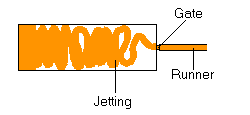|
This chapter explains molding defects such
as sink mark, warping and whitening and their prevention.
|
Molding defects are caused by related and complicated
reasons as follows:
- Malfunctions of molding machine
- Inappropriate molding conditions
- Flaws in product and mold design
- Improper Selection of molding material
Such problems are complicated and may not be resolved
with only one solution.
Therefore, it is difficult to solve the problems in a short period of time.
However, it is important to analyze the causes of the molding defects, attempt
to find proper solution and eliminate any defects.

|
Sink Mark
|
This is the phenomenon where a dent appears on
the surface of the product.
It is often observed on crystalline plastics
with a high shrinkage rate.
When there is a rib in the back of bumper,
a sink mark is created on the surface.
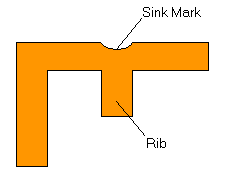
|
- Cause
- This is caused by shrinkage of the molten plastics during molding.
It is due to inconsistent thickness of molding, which accompanies
inconsistent cooling solidification.
- This means that pressure is not applied to every part of the
mold cavity. Even though
pressure is applied, it diminishes rapidly.
|
- Solution
- Raise injection pressure
and lower the temperature of molten plastics. The mold temperature
also needs to be lowered.
- Make the gate and
runner thick and add a gate where sink mark appears.
- Maintain uniform plastics thickness.
|

|
Warpage
|
This is the phenomenon where the part is warped
or twisted on removal from the mold.
Since molten plastics becomes solidified
while flowing, there can be deformation left within the part as residual stress.
This deformation appears when the part is removed from the mold and pressure
is released.

|
- Cause
-
- Shrinkage timing was missed due to the mold temperature difference
(surface temperature difference at cavity and core) .
- The volume of Shrinkage changed because of the thickness difference
in the part.
- Mold temperature was either too high or inconsistent, or cooling
was inconsistent.
- Molten plastics temperature was high.
- Injection pressure
was low.
|
- Solution
-
- Take a longer cooling time and lower the ejection speed.
- Adjust the ejector pin
position or enlarge the draft
angle.
- Examine the part thickness or dimension. Reduce liquid resistance
as much as possible to minimize internal deformation
|

|
Whitening
|
After the ejection
by the ejector pin, the surface of the ejected part or surrounding part turns
white.
When some portion of the part is hard to remove from the mold, that portion
also turns white. This phenomenon is called whitening.
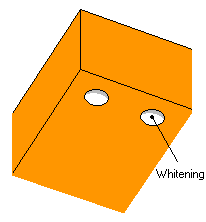
|
- Cause
-
- The part was hard to remove from the mold.
- Poor quality of the mold surface
|
- Solution
-
- Polish the mold well to facilitate removal of the part.
- Lower the injection pressure
to facilitate removal of the part.
- Reduce the ejector pin speed, and increase the number of ejector
pins.
|

|
Weldline
|
This is a phenomenon where a thin line is created when different flows of molten
plastics in a mold cavity meet and remain
undissolved.
It is a boundary between flows caused by incomplete dissolution of molten plastics.
It often develops around the far edge of the gate.
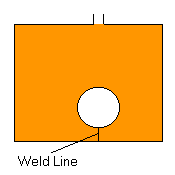
|
- Cause
- Low temperature of the mold causes incomplete dissolution of
the molten plastics.
|
- Solution
- Increase injection speed
and raise the mold temperature.
- Lower the molten plastics temperature and increase the injection
pressure
- Change the gate position and the flow of molten plastics.

Change the gate position to prevent development of weldline.
|

|
Flashes
|
Flashes develop at the mold parting
line or ejector pin installation
point. It is a phenomenon where molten plastics bulge out and stick to the
gap.
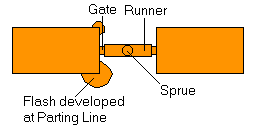
|
|
- Solution
- Avoiding excessive difference in thickness is most effective.
- Slow down the injection speed.
- Apply well-balanced pressure to the mold to get consistent clamping
force, or increase the clamping force
- Enhance the quality of the parting lines, ejector pins and holes.
|

|
Short Shot
|
This is the phenomenon where molten plastics does not fill the mold
cavity completely.
and the portion of parts becomes incomplete shape.
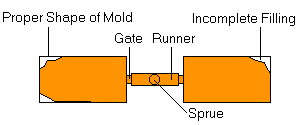
|
- Cause
- The injection volume or injection
pressure is insufficient.
- Injection speed is so
fast that the molten plastics become solid
before air within cavity is ejected.
- Injection speed is so slow that the molten plastics becomes solid
before it flows to the end of the mold.
|
- Solution
- Apply higher injection pressure.
- Install air vent or degassing
device.
- Change the shape of the mold or gate position for better flow of the plastics.
|

|
Jetting
|

|
Flow mark
|
This is a phenomenon where the initial flow of
molten plastics which solidifies mixes
with a later flow and remains undissolved. It develops distinctive patterns
such as clouds, scales or tree rings.
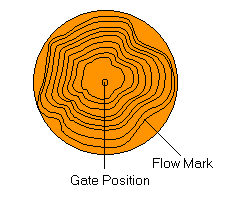
|
- Cause
- Injection speed is too
fast.
- Mold or molten plastics temperature is too low.
|
- Solution
- Enlarge the gate area to decrease the speed
of the molten plastics flowing through the gate.
- Increase the pressure retention time for better pressure quality.
|















